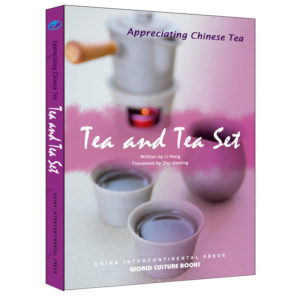Description
Author: Hong Li
Publishing house: China Intercontinental Press
Edition: 1 (Jan. 2010)
Page: 160
Format: 32
Preface:
According to the famous writer Zhou Zuoren, “Tea ceremony, simply speaking, is snatching a moment of leisure from our busy schedules, seeking delight and experiencing its permanence for a moment in the harsh realities of life.” These words still hold good in the modern society today.
The beauty and harmony of the tea ceremoy, the momentary permanence, brewing tea and sipping tea are enough to arouse eagerness in most people.
Abstract:
Why is tea the National drink of China? Why is tea regarded as symbolizing the harmony and mysterious unity of the Universe? Why is the loose-leaf Chinese tea more beneficial than the tea bags? How many types of Chinese tea are Available? How to make the best cup of Chinese tea? ……A visitor to the home of tea has so many questions. Understanding their answers will bring you closer to the history and mystery of tea. Appreciating Chinese Tea Series will help you.
Content:
Part 1 Knowing Tea from the Very Beginning
Clue 1: Basic Tea
Green Tea
Famous Green Teas
Yellow Tea
Famous Huangyacha Tea
Famous Yellow Teas
White Tea
Famous White Teas
Blue Tea
Famous Northern Fujian Blue Tea
Famous Minnan Blue Tea
Famous Blue Tea of Guangdong
Famous Taiwan Blue Tea
Preview:
Basic Tea Classifi cation Black TeaBlack tea, created in the early 17th century (some believe that it was the 19th century), originated from today’s Tongmuguang, Wuyishan City, Fujian. It is also called Souchong Black Tea, which is the first black tea in the world.Types of black tea according to processBlack tea is characterized by red liquid and red leaves. The rough process technology of black tea is: plucking fresh leaves → sun withering → twisting or cutting → fermenting → drying. Black tea is classifi ed into black strip tea and black broken tea. Black strip tea production requires full fermentation. The fl avor is mellow and sweet. It is compressed by two rollers at different speeds, cut and rolled. The fermentation degree is light. The polyphenol content in the tea is high. The taste is strong and fresh. In general, red strip tea is suitable for drinking without seasonings while red broken tea is more suitable for drinking with other additives.Red strip tea is classifi ed into Kongfu and Souchong black tea.Famous black tea: SouchongLapsang SouchongIt is classifi ed into Lapsang souchong and Waishan souchong. Lapsang souchong, produced in Tongmuguan, Xingcun Village of Wuyishan National Nature Reserve, is alsocalled Xingcun souchong or Tongmuguan souchong. Souchong, produced in Shaowu, Guangze, Zhenghe, Tanyang, Beiling, Gutian, Pingnan, Shaxian of Fujian and Qianshan of Jiangxi, is of poor quality and is called Waishan souchong or artificial souchong, no longer in the market today. However, thanks to its century-old popularity, Lapsang souchong is popular among European countries, especially the royalty of the UK. The leaves of the dry tea are compact and thick. It is dark with a lingering pine aroma. The liquid is yellow and tastes mellow with a longan fl avor. The brewed leaves are thick and bronze-colored.



























